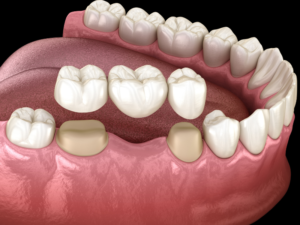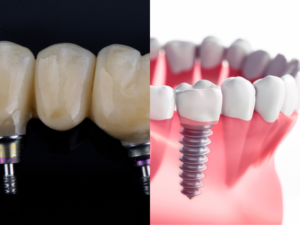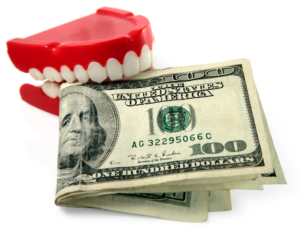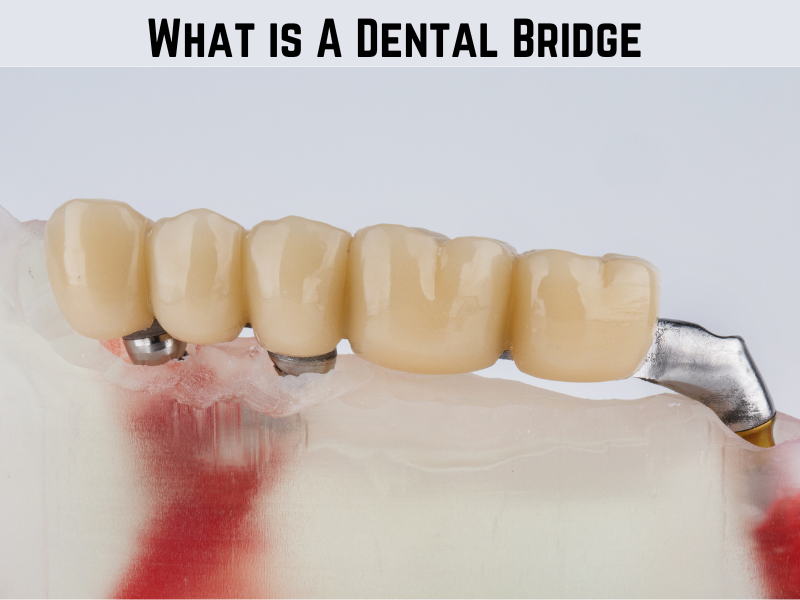Missing teeth can negatively influence your dental health, confidence, and ability to perform daily tasks such as chewing and speaking. Dental bridges, fortunately, provide an efficient alternative for restoring your smile and oral functionality. But just what is a dental bridge?
Whether you have a missing tooth or multiple nearby gaps, dental bridges can help restore the look of your smile, prevent teeth from shifting, and improve your bite and chewing abilities.
Join us to learn about the various dental bridges, their benefits, how to care for them properly, and their cost. Get ready to understand what is a dental bridge and how it can improve your smile and general quality of life.
What is a Dental Bridge?

A dental bridge is a permanent appliance for a single missing or multiple missing teeth with a natural-looking and functional replacement. Dental bridges, as opposed to partial dentures, provide a permanent, long-term solution that improves chewing, speaking, and the appearance of your teeth.
Dental bridges restore oral functionality and give you the confidence to eat, speak, and smile without worrying about the gaps produced by lost teeth by seamlessly fitting into the gap. They offer a permanent tooth replacement alternative that integrates with your existing teeth, providing functional and aesthetic benefits.
What Are Dental Bridges Made of?
Dental bridges are made from various materials, including gold, metals, and porcelain. Because of its perfect fit with your natural tooth color, porcelain is widely utilized to replace front teeth. This guarantees that the dental bridge blends in with your natural teeth, resulting in a natural and aesthetically acceptable result.
Types of Dental Bridges
Dentists use many types of dental bridges to achieve specific oral health goals. The following are the four basic types of dental bridges:
Traditional Dental Bridge
The most popular variety is the traditional dental bridge, which consists of dental crowns (caps) on both ends and pontics (fake teeth) in between. The crowns are glued to healthy natural teeth on each side of the gap (abutments), and the pontics fill the area. Traditional bridges are appropriate when both sides of the gap have healthy natural teeth.
Cantilever Dental Bridge
Like a regular bridge, a cantilever bridge has a crown on only one end rather than both. The bridge is linked to the abutment tooth, and the pontic (artificial tooth) bridges the gap. When just one side of a gap has natural teeth, a cantilever bridge is used. They are, however, not as robust as typical bridges due to their design.
Maryland Dental Bridge
Maryland bridge secures the bridge using metal wings rather than crowns. These wings are linked to the backs of adjoining teeth to keep the bridge in place. Maryland bridges typically replace front teeth since they cannot sustain the biting forces on rear teeth.
Implant-Supported Bridge
An implant-supported bridge is comparable to a typical bridge, but dental implants rather than natural teeth support it. Dental implants are small threaded posts used to replace lost tooth roots.
A fusion procedure occurs before attaching a bridge to implants, during which the implants fully fuse into the jawbone. Usually, it takes three to six months, but it might take longer, depending on the individual. Implant-supported bridges are used when three or more missing teeth are in a row.
Process of Getting a Dental Bridge

While having a dental bridge, you need to visit the dentists clinic two times:
First Visit
- Preparation of abutment teeth: The adjacent teeth to the gap are recontoured by removing a small portion of the enamel. It creates room for the placement of crowns.
- Impression taking: Impressions of your teeth are made, serving as a model for the dental lab to create the bridge, pontic (artificial tooth), and crowns. Meanwhile, a temporary bridge protects the exposed teeth and gums during the bridge fabrication.
Second Visit
- Removal of temporary bridge: The temporary bridge is removed, and the newly crafted porcelain or metal bridge is checked for proper fit.
- Adjustments and fittings: To provide a comfortable and perfect fit, the bridge is adjusted as needed. Depending on the individual’s circumstance, multiple visits may be required to assess the fit of the metal framework and bite.
- Temporary cementation (if needed): Your dentist may temporarily cement a fixed bridge in place for a few weeks to ensure correct fit and functionality.
- Final cementation: After a couple of weeks, the bridge is permanently cemented into place once the fit and bite are confirmed.
Why Would You Need a Dental Bridge?
Your dentist may recommend dental bridges if you’re missing one or multiple teeth. The gaps left by missing teeth can severely affect your oral health and overall well-being. Here are some of the most common reasons why you might require a dental bridge:
Restoring Your Smile

A dental bridge replaces the gap created by lost teeth, creating a complete and aesthetically pleasing smile.
Restoring Normal Chewing Ability
A dental bridge can assist you in regaining the ability to chew food comfortably and efficiently, thereby enhancing your overall nutrition and digestion.
Restoring Speech & Pronunciation
Speech and pronunciation can be affected by missing teeth, but a dental bridge can help restore proper pronunciation and clarity.
Maintains Facial Shape
By filling gaps, a dental bridge helps to keep your face’s natural shape and curves, preventing a sunken or collapsed appearance.
Readjusting Bite Alignment
A dental bridge ensures chewing force is transferred equally among the teeth, reducing undue stress on specific places and restoring a balanced bite.
Prevents Teeth Shifting
A dental bridge helps retain the remaining teeth in their proper places, preventing them from shifting or tilting due to the gap left by missing teeth.
Bite stability
Dental bridges help preserve good bite alignment by preventing adjacent teeth from slipping into the vacant gap. It prevents bite difficulties and complications caused by dental misalignment.
What is the Disadvantage of a Dental Bridge?
Dental bridges have some drawbacks that you should be aware of. The following are the primary drawbacks of dental bridges:
- Abutment tooth damage: The teeth supporting the dental bridge may be damaged or decayed. It can jeopardize the bridge’s structure and durability.
- Risk of deterioration: If a bridge or crown does not fit properly, germs and plaque can accumulate beneath it, causing tooth decay and other oral health issues.
- Changes in tooth structure and bite: Installing crowns for a dental bridge might change the structure and form of your natural teeth, affecting your bite alignment. To minimize any negative impacts, appropriate fit and alignment are critical.
- Bridge failure or collapse: Bridge failure or collapse is possible when the abutment teeth are not strong enough to support the bridge. Before starting with a bridge, it is critical to check the strength and condition of the abutment teeth.
- Abutment tooth deterioration: The preparation of abutment teeth for a bridge may weaken tooth structure. For long-term dental health, this may need the replacement of abutment teeth with dental implants in some circumstances.
How Many Teeth Are Needed for a Bridge?
A dental bridge is often used to replace one to three consecutive teeth. In exceptional cases, a bridge can replace up to four consecutive teeth. Keep in mind, however, that longer bridges often require more support. Healthy natural teeth on both sides of the gap are required to replace four lost teeth with a bridge.
Dental Bridge vs. Implant — Which One is Better?

Dental implants, on average, have a longer lifespan than bridges. Implants also provide the advantage of conserving existing bone and lowering the risk of future bone loss.
However, it is crucial to note that each individual has different oral health needs, goals, and preferences. You must consult your dentist to establish the best treatment option for your unique case.
They will assess your dental health, consider your preferences, and make specific recommendations based on their knowledge. Make an informed selection that corresponds with your oral health goals and assures the greatest potential outcome for your dental repair by speaking with your dentist.
How Long Do Dental Bridges Last?
Dental bridges can endure five to fifteen years or more. However, with excellent oral hygiene and regular dental exams, it is not uncommon for a fixed bridge to last more than ten years. By practicing proper oral hygiene and getting competent dental care, you can considerably extend the life of your dental bridge, ensuring its durability and functionality for a long time.
Dental Bridge Cost Without Insurance

Dental bridge cost varies depending on several factors, including:
- Number of teeth involved: The cost of teeth involved may be determined by the number of teeth required to bridge the gap.
- Materials utilized: The materials used, such as composite resin, zirconia, or metal alloy coated in resin, might have an impact on the overall cost of the bridge.
- Complexity of the placement: The intricacy or difficulty of the bridge placement technique may impact the pricing.
- Additional treatments: The entire cost may be affected if additional dental issues exist, such as gum disease or the need for different treatments.
- Geographic location: Dental services cost varies depending on where you live and the local market rates.
The total cost is also determined by the type of bridge chosen:
- Traditional or cantilever bridges cost between $2,000 and $5,000 per pontic, including a crown for each abutment tooth.
- Maryland bridges typically cost between $1,500 and $2,500 per pontic, which includes the framework or wings linked to the abutment teeth.
- An implant-supported bridge can cost between $5,000 and $15,000 for a three or four-tooth bridge supported by two dental implants.
Valley Ridge Dental accepts insurance from various insurance providers, third-party financing, and credit card options.
Can a Dental Bridge be Removed & Recemented?
If your bridge is already loose, it should be simple to remove. Your dentist can usually recement it without any problems. However, if you need your bridge removed for another reason, such as treating gum disease or underlying tooth decay, it may shatter during the removal process. If this occurs, you will require a new dental bridge.
Do Bridges Feel Like Natural Teeth?
It may take some time to adjust to your new dental bridge. However, it should feel comparable to your teeth once you do so. It’s similar to putting a new ring on your finger. You’re conscious of it for a while but gradually grow acclimated to it.
Conclusion
Missing teeth cause a gap in your smile, making it difficult to chew and speak effectively. A dental bridge may be possible if you miss one to four teeth in a row. Bridges are more comfortable than partial dentures and less expensive than dental implants.
Consult with the dentists of Valley Ridge Dental about tooth replacement options if you lack teeth. They can assist you in locating a solution that meets your requirements, budget, and preferences.
Call 6514390322 to book your appointment now!
FAQs
-
Is getting a dental bridge painful?
Typically, traditional bridges are not uncomfortable; however, if you have any worries, it’s advisable to discuss them with your dentist. They can assist you in determining if a dental bridge is a suitable dental solution for your needs.
-
Do bridges feel like real teeth?
Crowns are crafted to closely resemble natural teeth, ensuring a familiar sensation. Initially, you might experience slight discomfort and tenderness with a new bridge as your mouth adapts, but this is usually temporary. Please inform us if the discomfort worsens or persists beyond a few days.
-
How soon can I eat after getting a bridge?
Following the placement of dental bridges, avoiding sticky foods for the initial 24 hours is recommended. Afterward, you can resume your regular eating, drinking, and dental care routine.





